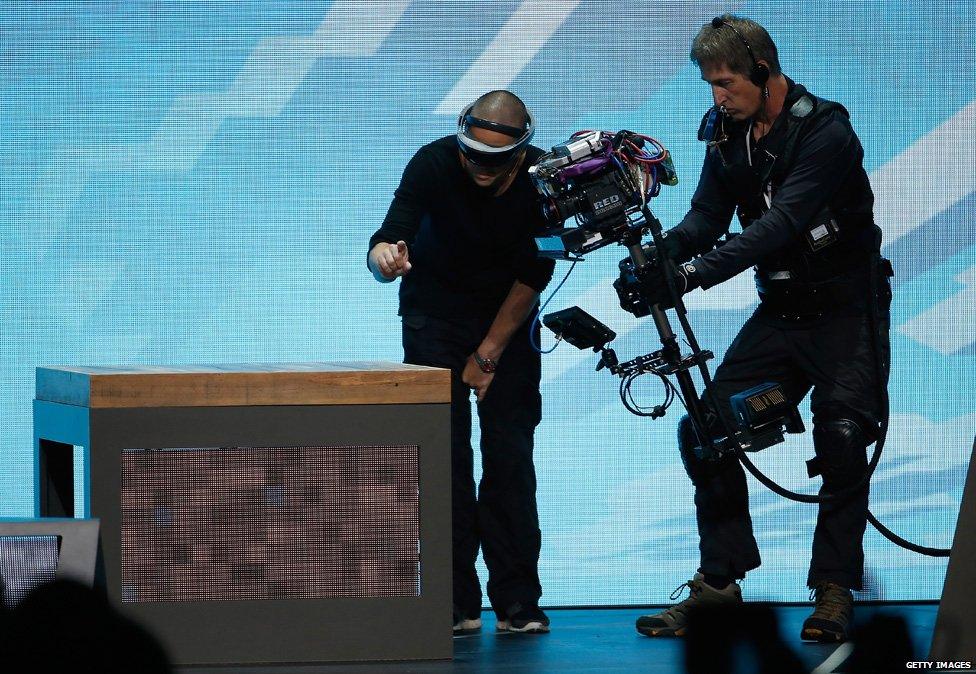At E3, virtual becomes real
- Published
- comments
Rory Cellan-Jones virtual reality
In the past few days I've taken part in a London jewel raid, and ended up in a shootout with my fellow conspirators.
I've stood on the bridge of an American battleship, trying to decide whether a small boat a mile or so away is occupied by pirates and if so what action I should take. And I have watched as an entire world in toy bricks animate suddenly upon a coffee table.
No, I've not been drinking, I'm at E3, the annual shindig of the video games industry in Los Angeles. Games makers have been taking us into fantastical and immersive worlds for years, but now they are excited by the potential of creating a whole new reality for players.
That is, virtual reality. In just a couple of years, the technology which was tried and failed in the 1990s has made a stunning comeback. It started when Oculus Rift raised record amounts on Kickstarter for its VR headset, and now everyone from Sony to Samsung to Google is gearing up to take us into virtual worlds.
That jewel raid I mentioned came courtesy of London Heist, a demo game Sony is showing off. You don the Morpheus headset, put a controller in each hand and you find yourself behind an antique desk in a library. The controllers become your hands, you use them to open a desk drawer and take out a gun - which comes in useful when three men come bursting in firing weapons at you. The scenario felt so real that I found myself dropping the "gun" on the floor when I tried to put it on the desk.
Sony's Morpheus is supposed to arrive as a consumer product early next year, along with Oculus Rift. By then, however, Valve's Vive VR headset, made in collaboration with the phone manufacturer HTC, should be on the market. And you can already get a pretty good virtual reality experience by slotting a smartphone into the Samsung Gear VR headset, or even into Google's very simple Cardboard, which took me on an interactive tour around the Palace of Versailles.

A demonstration of Microsoft's HoloLens
Another technology giant Microsoft is working with both both Oculus and Vive but also has its own take. The HoloLens headset offers what is being called mixed reality, and an impressive demo at the XBox event saw a player animating an entire virtual Minecraft world on a real coffee table. What's not clear is how far HoloLens has travelled along the road to becoming a consumer product.
But why is virtual reality suddenly so hot? I found some of the answers in an anonymous office unit in Los Angeles. Inside, in a space which felt like a cross between a TV studio and a tech startup, lives the mixed reality lab of the Institute for Creative Technologies, part of the University of Southern California, external.
The Institute brings together a diverse mix of film students and computer scientists, trying to bring the creative thinking of Hollywood to bear on the challenge of creating immersive worlds. It is funded by the United States Department of Defense, and much of its work is intended for use in military training. Hence that scenario I talked about earlier where you find yourself on the bridge of a warship directing operations.
The Institute did a lot of work on making cheap headsets, including one cardboard prototype, and then made that project open source - it looks as though this is where Google got the idea for its Cardboard device. And Palmer Luckey, founder of Oculus Rift, was on the staff here until a few months before he launched the kickstarter for his VR headset.
The director of the lab, Mark Bolas, is a VR veteran having worked in the field since the late 1980s. As he showed me round, he had the air of a man whose life's work was finally coming to fruition after years in the wilderness. "I find that question difficult to answer," he told me when I asked which areas of life might benefit from virtual reality technology. "Because I can't think of an area which it is not going to affect."
Scientists, games developers, and some of the biggest forces in technology now seem convinced that virtual reality is an idea whose time has come. Now all they need to do is convince millions of us that we really want to strap on a headset and enter another world.